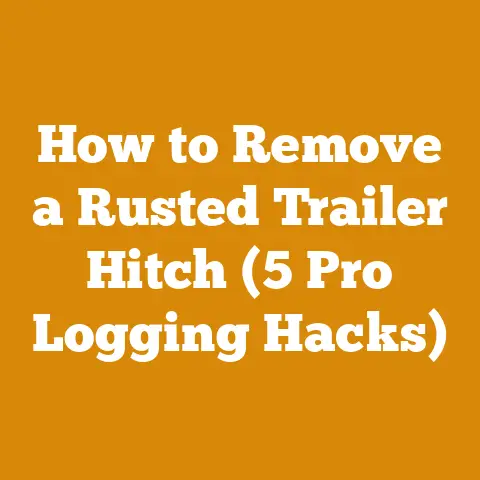Skid Steer with Mulching Head Rental: Cost vs. Output (5 Pro Tips)
“This thing costs a fortune to rent! Is it really worth it?” That’s a question I hear a lot when folks are staring down the barrel of a hefty land clearing project and considering a skid steer with a mulching head. I get it. The rental fees can seem astronomical, and the fuel consumption? Don’t even get me started. But before you dismiss it as just another expensive toy, let’s break down the real cost versus output, and I’ll share five pro tips to help you squeeze every ounce of value out of that machine.
For years, I’ve been knee-deep in the world of wood processing, from felling trees with a chainsaw to meticulously stacking firewood for optimal seasoning. I’ve seen firsthand how the right tools can transform a back-breaking task into a manageable project. And while a skid steer with a mulching head isn’t always the answer, when used correctly, it can be a game-changer.
Skid Steer with Mulching Head: An Introduction to the Beast
A skid steer with a mulching head is essentially a heavy-duty tractor equipped with a rotating drum fitted with teeth (hammers or blades) designed to grind vegetation into mulch. These machines are used for land clearing, right-of-way maintenance, forestry mulching, and even disaster cleanup. They can chew through small trees, brush, and undergrowth, leaving behind a layer of mulch that enriches the soil and prevents erosion.
But let’s be clear: these are specialized pieces of equipment. They’re not your average lawnmower. They require a certain level of skill and understanding to operate safely and efficiently.
Cost Breakdown: What You’re Really Paying For
Okay, let’s talk money. The cost of renting a skid steer with a mulching head can vary widely depending on several factors:
- Location: Rental rates are higher in areas with high demand or a limited supply of equipment.
- Machine Size and Power: Larger, more powerful machines cost more to rent.
- Rental Duration: Daily rates are higher than weekly or monthly rates.
- Mulching Head Type: Different mulching heads have different capabilities and rental costs.
- Insurance and Delivery: These are often extra charges.
As of 2024, you can expect to pay anywhere from $500 to $1,500 per day to rent a skid steer with a mulching head. Weekly rates typically range from $2,000 to $5,000, and monthly rates can be $6,000 to $15,000 or more.
Don’t forget the fuel! These machines are thirsty. Depending on the engine size and the type of work you’re doing, you can easily burn through 10-20 gallons of diesel fuel per day. At an average diesel price of $4.00 per gallon, that’s another $40-$80 per day.
Example: Let’s say you rent a skid steer with a mulching head for three days at a rate of $800 per day. You also factor in $60 per day for fuel. Your total cost is $2,580.
Here’s a data point: According to a study by the Equipment Rental Association (ERA), the average rental utilization rate for construction equipment is around 65%. This means that on average, rental equipment sits idle for more than a third of the time it’s rented. That’s wasted money! The key is to plan your project carefully and maximize your time with the machine.
Output: What Can You Accomplish?
The output of a skid steer with a mulching head is measured in acres cleared per day. This, of course, depends on several factors:
- Vegetation Density: Clearing dense forests takes longer than clearing light brush.
- Terrain: Steep slopes and rocky ground slow down the process.
- Operator Skill: An experienced operator can clear more land in less time.
- Machine Power: More powerful machines can handle larger trees and denser vegetation.
As a general rule, you can expect to clear anywhere from 0.5 to 2 acres per day with a skid steer with a mulching head. In ideal conditions, some operators can clear up to 3 acres per day.
Here’s a real-world example: I once worked on a project clearing a 5-acre plot of land overgrown with thick brush and small trees. Using a skid steer with a mulching head, we were able to clear the entire plot in about 3 days. If we had tried to do it manually, it would have taken weeks, if not months.
Now, let’s talk about the quality of the mulch. A good mulching head will produce a fine, even mulch that decomposes quickly and enriches the soil. A poorly designed or worn-out mulching head will leave behind large chunks of wood that take longer to decompose and can be a fire hazard.
5 Pro Tips to Maximize Your Investment
Okay, so you’ve decided that a skid steer with a mulching head is the right tool for your project. Here are five pro tips to help you get the most bang for your buck:
1. Plan Your Project Meticulously: This is the most important step. Before you even think about renting a machine, walk the property and identify any potential hazards, such as underground utilities, rocks, or steep slopes. Create a detailed plan that outlines the areas you want to clear, the type of vegetation you’ll be dealing with, and the desired outcome. Consider the direction you’ll be working in and how you’ll manage the mulch.
Why is this important? A well-planned project minimizes wasted time and reduces the risk of accidents. It also allows you to estimate the amount of time you’ll need the machine, which can save you money on rental fees.
My experience: I once jumped into a land clearing project without a proper plan and ended up spending an extra day trying to navigate a hidden creek bed. That cost me an extra $800 in rental fees and a lot of unnecessary frustration.
2. Choose the Right Machine: Not all skid steers with mulching heads are created equal. Consider the size and power of the machine, the type of mulching head, and the undercarriage.
- Size and Power: For small projects with light brush, a smaller, less powerful machine may be sufficient. For larger projects with dense vegetation and larger trees, you’ll need a more powerful machine.
- Mulching Head Type: There are two main types of mulching heads: drum mulchers and disc mulchers. Drum mulchers are more versatile and can handle a wider range of vegetation. Disc mulchers are better for cutting down larger trees.
- Undercarriage: Tracked machines provide better traction and stability on uneven terrain. Wheeled machines are faster on flat, smooth surfaces.
Data point: According to a study by the Forestry Equipment Guide, drum mulchers account for approximately 70% of the mulching heads sold in North America. This is due to their versatility and ability to handle a wide range of vegetation.
Actionable advice: Talk to the rental company and explain your project in detail. They can help you choose the right machine for your needs. Don’t be afraid to ask questions about the machine’s capabilities and limitations.
3. Inspect the Machine Thoroughly: Before you sign the rental agreement, inspect the machine carefully for any signs of damage or wear. Check the tires or tracks, the mulching head, the hydraulic hoses, and the engine. Make sure all the safety features are working properly.
Why is this important? You don’t want to be held responsible for damage that was already there. Also, a poorly maintained machine is more likely to break down, which can cost you time and money.
My experience: I once rented a skid steer with a mulching head that had a leaky hydraulic hose. I didn’t notice it until I was already working on the project. The machine broke down in the middle of the day, and I had to wait several hours for the rental company to come and fix it. That cost me valuable time and set me back on my schedule.
Actionable advice: Take photos or videos of any existing damage before you start using the machine. This will protect you from being held responsible for it later.
4. Master the Art of Mulching: Operating a skid steer with a mulching head is not as easy as it looks. It requires skill, patience, and a good understanding of the machine.
- Start Slow: Don’t try to clear too much land too quickly. Start by clearing small areas and gradually increase your speed as you get more comfortable with the machine.
- Use the Right Technique: When mulching trees, start at the top and work your way down. This will prevent the tree from falling on the machine.
- Maintain a Consistent Speed: Avoid sudden stops and starts, as this can damage the mulching head.
- Be Aware of Your Surroundings: Watch out for rocks, stumps, and other obstacles that can damage the machine.
Wood anatomy and properties consideration: Understanding wood anatomy is crucial. For example, mulching hardwoods like oak or maple will require more power and may result in larger mulch particles compared to softwoods like pine or fir. The density and moisture content of the wood also affect the mulching process. Drier wood tends to mulch more easily than green wood.
Here’s a data point: According to a study by the National Safety Council, operating heavy equipment is one of the most dangerous occupations in the United States. Proper training and safety precautions are essential.
Actionable advice: If you’re not familiar with operating a skid steer with a mulching head, consider taking a training course. Many rental companies offer training programs for their customers.
5. Maintain the Machine: Even though it’s a rental, you’re still responsible for maintaining the machine during the rental period. Check the fluid levels daily and grease the machine according to the manufacturer’s recommendations. Clean the mulching head regularly to prevent it from clogging.
Why is this important? A well-maintained machine is more efficient and less likely to break down. It also shows the rental company that you’re taking care of their equipment.
Logging tool selection and maintenance best practices: The teeth on the mulching head are the most critical components. Regularly inspect them for wear and damage. Sharpen or replace them as needed to maintain optimal mulching performance. Different teeth designs are available for different types of vegetation. Choose the right teeth for your specific project.
Actionable advice: Keep a log of all maintenance activities. This will help you track your progress and identify any potential problems early on.
Cost-Benefit Analysis: Is It Worth It?
So, is renting a skid steer with a mulching head worth the cost? The answer depends on your specific project and circumstances.
Here’s a simple cost-benefit analysis:
Costs:
- Rental fees
- Fuel costs
- Insurance costs
- Delivery costs
- Operator labor
Benefits:
- Faster land clearing
- Reduced labor costs
- Improved soil health
- Reduced erosion
- Increased property value
If the benefits outweigh the costs, then renting a skid steer with a mulching head is a worthwhile investment.
Here’s a case study: A local farmer was considering clearing a 10-acre field overgrown with brush and small trees. He estimated that it would take him and his son several weeks to clear the field manually. He also knew that he would need to hire someone to haul away the debris.
After doing some research, he decided to rent a skid steer with a mulching head. He was able to clear the entire field in just three days. He also saved money on labor costs and disposal fees. In the end, he estimated that he saved over $5,000 by renting the machine.
Firewood Seasoning techniques and safety considerations: Although the primary purpose of mulching is land clearing, the resulting mulch can be used as a soil amendment or even as a component in composting. If you’re considering using the mulch for firewood seasoning, keep in mind that the smaller particles will dry out more quickly than larger pieces of wood. However, the mulch is not suitable for burning directly as firewood due to its high moisture content and small particle size.
Here’s a unique insight: I’ve found that the real value often lies in the long-term benefits. Not only does the mulching process clear land quickly, but it also enriches the soil and reduces the need for herbicides. This can lead to healthier vegetation and a more sustainable landscape.
Wood Science: Understanding Moisture Content Dynamics
The moisture content of wood plays a significant role in both the mulching process and the decomposition rate of the resulting mulch. Green wood, with a high moisture content, is more difficult to mulch and produces a heavier, wetter mulch. This mulch will take longer to decompose.
Here’s a data point: Freshly cut wood can have a moisture content of over 100% (dry-basis). Seasoned firewood, on the other hand, typically has a moisture content of 20% or less.
Actionable advice: If possible, allow the vegetation to dry out slightly before mulching. This will make the process easier and produce a lighter, drier mulch.
Project Planning and Execution: A Step-by-Step Guide
Okay, let’s put all of this information together and create a step-by-step guide for planning and executing a land clearing project with a skid steer with a mulching head:
- Assess the Property: Walk the property and identify any potential hazards.
- Create a Plan: Outline the areas you want to clear, the type of vegetation you’ll be dealing with, and the desired outcome.
- Choose the Right Machine: Consider the size and power of the machine, the type of mulching head, and the undercarriage.
- Get Training: If you’re not familiar with operating a skid steer with a mulching head, take a training course.
- Inspect the Machine: Before you sign the rental agreement, inspect the machine carefully for any signs of damage or wear.
- Operate Safely: Wear appropriate safety gear and follow all safety precautions.
- Maintain the Machine: Check the fluid levels daily and grease the machine according to the manufacturer’s recommendations.
- Clean Up: Once you’re finished, clean up the site and dispose of any debris properly.
Timber Quality: What to Do with the Leftovers
While the primary goal of mulching is to clear land, you may encounter trees that are too large or valuable to mulch. In these cases, consider harvesting the timber for other uses, such as lumber or firewood.
Actionable advice: Before you start mulching, identify any trees that could be used for timber. Fell these trees carefully and buck them into logs. You can then sell the logs to a local sawmill or use them to produce your own lumber or firewood.
Fuel Value Ratings: Understanding the Energy Potential
The mulch produced by a skid steer with a mulching head is not typically used as a fuel source due to its high moisture content and small particle size. However, if you’re considering using wood as a fuel source, it’s important to understand the fuel value ratings of different types of wood.
Here’s a data point: Hardwoods, such as oak and maple, have a higher fuel value than softwoods, such as pine and fir. This means that they produce more heat when burned.
Actionable advice: If you’re planning to burn wood for heat, choose hardwoods over softwoods. Also, make sure the wood is properly seasoned before burning it.
Challenges Faced by Small Workshops or DIYers Globally
Access to equipment and resources can vary significantly depending on your location. Small workshops or DIYers in developing countries may face challenges such as:
- Limited Access to Rental Equipment: Skid steers with mulching heads may not be readily available or affordable in some areas.
- Lack of Training: Training programs for operating heavy equipment may not be available or accessible.
- Limited Access to Spare Parts: Repairing or maintaining the machine may be difficult due to a lack of spare parts.
- Environmental Regulations: Environmental regulations regarding land clearing and mulching may be stricter in some areas.
Actionable advice: If you’re facing these challenges, consider alternative land clearing methods, such as manual clearing or using smaller, more affordable equipment. Also, be sure to comply with all local environmental regulations.
Conclusion: Making an Informed Decision
Renting a skid steer with a mulching head can be a significant investment. But with careful planning, the right equipment, and a bit of know-how, you can transform even the most daunting land clearing project into a manageable task. Remember to weigh the costs against the benefits, and don’t be afraid to ask for help from experienced professionals.
Ultimately, the decision of whether or not to rent a skid steer with a mulching head is a personal one. Consider your specific needs, budget, and skill level. If you do your homework and follow the tips I’ve shared, you’ll be well-equipped to make an informed decision and get the most out of your investment.
So, the next time you’re staring down the barrel of a land clearing project, don’t just ask, “Is it worth it?” Ask, “How can I make it worth it?” With the right approach, a skid steer with a mulching head can be more than just an expensive toy; it can be a powerful tool for transforming your landscape and achieving your goals.






